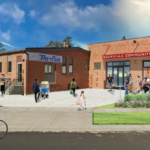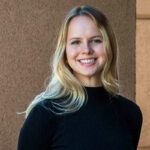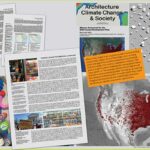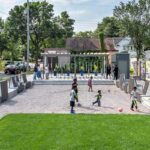Faculty News
Innovative and Relevant
The School of Architecture & Urban Planning faculty disseminate their research, scholarship, and design work through grants, articles, competitions, panel sessions, and conference presentations.
Professor Jim Wasley taught a week long workshop at Jade University in Oldenburg, Germany, on the design of ecological urban waterscapes. Oldenburg is on the northern plains of Germany close to the Baltic Sea. Much like the Netherlands just to the west, water here is a constant presence in the environment, and one that offers interesting insights into the problems of urban water design in Wisconsin.
Jim has been involved with the Greenfield Gateway Project, the redevelopment of Milwaukee’s inner harbor area, bordered roughly by 1st Street, Pittsburgh Street, the harbor, and the Kinnickinnic River. That area includes University of Wisconsin-Milwaukee’s School of Freshwater Sciences, which opened in 2014 at 600 E. Greenfield Avenue, overlooking the harbor.
One of the first projects to be realized is the Freshwater Plaza development ecological storm water demonstration project that was completed in June and includes the Gateway Fountain that captures 40,000 gallons of storm water from the roofs of the Freshwater Plaza apartments. This water is filtered through engineered wetland planters without the use of chemicals. As a water technology demonstration site, it is currently hosting Veolia’s RainNET internet-connected control system that will manage the water level in the fountain’s cistern system through predictive weather analytics. The fountain’s water will further be treated by the planned installation of a Solar Water Works PECO Solar-UV sterilization system in a novel configuration designed to exploit the fountain’s pump system for its own circulation. The creation of this fountain has been a collaborative effort between the UWM Institute for Ecological Design, The Milwaukee Department of City Development, Wangard Associates and the Milwaukee Metropolitan Sewerage District (MMSD). Additional funding has been provided by the Brico Fund and the fund for Lake Michigan.
At the end of Greenfield Avenue just east of the Greenfield Gateway, a companion fountain is under construction that will celebrate water at the west entrance to the UWM School of Freshwater Sciences. This fountain will intercept discharge water from the School’s aquaculture research facilities, treat it with ozone, and discharge it through a sculptural sluice into a reflecting pool that will be filled with aquatic habitat by students of the School. Together, these two fountains are meant to collapse the divide between the city and the harbor, connecting the School of Freshwater Sciences to the community.
Wasley entered the “Take me to the River” competition for a small public plaza with a team that included Assistant Professor Kyle Reynolds, the internationally celebrated artist Mary Miss, landscape architect Ed Freer, and lighting designer Marty Peck. While not selected, the scheme was notable for proposing a SARUP student design/build process as the vehicle for producing and executing the conceptual design. The scheme also provided access to the water for kayakers in the initial and funded phase of the project.
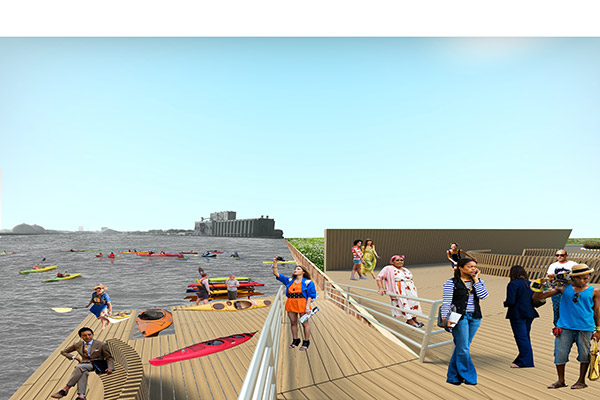
LEAD DESIGNER
James Wasley, Professor
CIVIL ENGINEER OF RECORD AND THE PROJECT MANAGER
Chris Carr, Sigma Engineering
TECHNICAL DESIGN AND INSTALLATION
Aquascapes, Inc.
ContRols equipment
Watertronics, Inc.
GENERAL CONTRACTOR
Berg Electric
Associate Professor Robert Schneider on a Future Milwaukee
Associate Professor Robert Schneider of the Department of Urban Planning spoke on a Future Milwaukee leadership panel, “Weaving Urban Development and Transportation in Milwaukee,” on April 24, 2017. Future Milwaukee is a program organized by Christine Hill of Marquette University. Other panelists included Matt Dorner (Milwaukee Downtown Business Improvement District), Vanessa Koster (Milwaukee Department of City Development), and Joe Peterangelo (Public Policy Forum). The panel discussed exciting, new, and forward thinking projects related to transportation and urban development in Milwaukee, including the Milwaukee streetcar, Bus Rapid Transit, bicycle network expansion, transit-oriented development, and ways to create safer and more walkable streets for all. It also covered challenges related to these new initiatives and critical transportation and development policy issues that Milwaukee should address.
Bob was invited to speak on bicycle and transportation research at other venues this year: “Lessons Learned from the Wisconsin Pedestrian and Bicycle Crash Analysis,” Green Lake County Traffic Safety Committee, Green Lake, Wisconsin; “Strategies to Make Walking & Bicycling Routine: Examples from Leading Communities,” University of Wisconsin-La Crosse, Public Presentation, La Crosse; “Milwaukee’s Path to Platinum Bicycle Initiative,” Milwaukee Business Improvement District Council Meeting; also presented at the Wisconsin Bicycle Summit, Milwaukee; and “Bus Rapid Transit: A New, Fast Transit Option for the Milwaukee Region?” School of Architecture and Urban Planning Design and Development Forum.
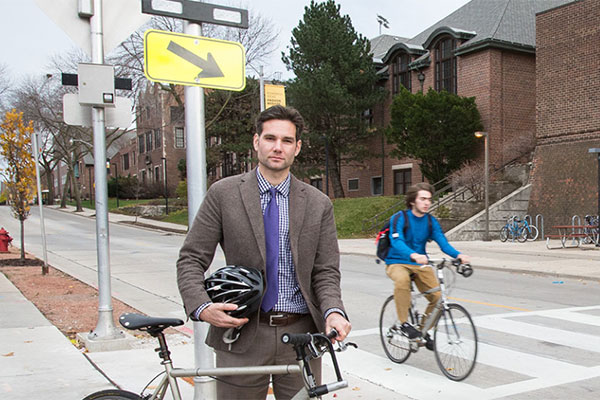
Associate Professor Kyle Talbott designed the new Bonsai Exhibit at the Lynden Sculpture Garden in River Hills, Wisconsin, a collaboration with The Lynden Foundation, the Milwaukee Bonsai Society, and the Milwaukee Bonsai Foundation. The Bonsai Exhibit includes a display area for twenty bonsai and a waterside teaching patio. The area will be a place to admire bonsai in season, to participate in workshops, or to enjoy the peaceful setting.
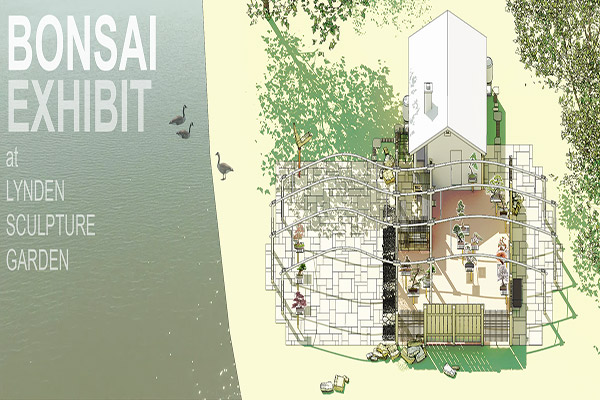
Associate Professor Nancy Frank, Chair of Urban Planning, presented “Using Green Infrastructure for Flood Mitigation in Dense Urban Watersheds,” at the American Planning Association conference in Phoenix. She also presented “Brownfields 101: Economic Analysis of Brownfields Grants,” at the Wisconsin Department of Natural Resources Brownfields Workshop in Stevens Point, Wisconsin.
Pneumatic Structures
Conceived in collaboration with local artists Katy Cowan and Nicholas Frank at The Open in Milwaukee’s Riverwest neighborhood, The Warming Hive is a pneumatic (air-filled) structure designed by a group of undergraduate and graduate architecture students taught by Assistant Professor Whitney Moon in Fall 2016.
Because The Open is comprised of several curatorial platforms—the Nicholas Frank Public Library (NFPL), Microlights, The Oven, The Outlet, and the Designers Talking Library—the objective of this temporary architectural installation is to engage multiple programs simultaneously while providing an outdoor gathering space for gallery visitors during an opening event. In addition to being “plugged-in” to The Outlet—an electrical outlet curated by Cowan inside the gallery—The Warming Hive was designed to engage The Oven, an outdoor brick oven run by artist John Riepenhoff, both thermally and socially. For this opening event, Peter Sandroni, the head chef at La Merenda and Engine Company No. 3 prepared food in The Oven, in collaboration with ceramicist Shelby Page. Sandroni’s culinary delights were prepared in Page’s custom earthenware and enjoyed in the comfort of an inflatable environment.
The Warming Hive realizes a collaborative student research and design project exploring pneumatic technology in relationship to mobility, sociability, environmental responsibility and pedagogical advancement. Adaptable to a variety of site and seasonal conditions, this pneumatic structure offers capabilities of implementation and transportation that cannot be matched by traditional construction: it is inflated in under three minutes, and can be easily packed up and transported to various locations throughout the city. Designed with built-in pneumatic seating and an insulated, fireproof, and projection-friendly skin, The Warming Hive provides a thermally comfortable winter shelter for exhibition, cooking and gathering. It can also be deployed for a variety of temporary and event-based uses. By utilizing the manufacturing expertise of Landmark Creations from Minnesota, this structure is able to have a lifespan of many years, rather than days, changing the typical perception of pneumatics structures as disposable, wasteful, and unreliable.
The Warming Hive was born out of a seminar on inflatable architecture entitled “Pillow Talk: Blow Up!” taught by Assistant Professor Whitney Moon. The course focused on a series of concepts pertaining to temporary, mobile and event-based architectures, with an emphasis on designing and fabricating air-filled structures. This was a unique opportunity for architecture students to learn about design-build and installation practices and to engage with the local arts community.
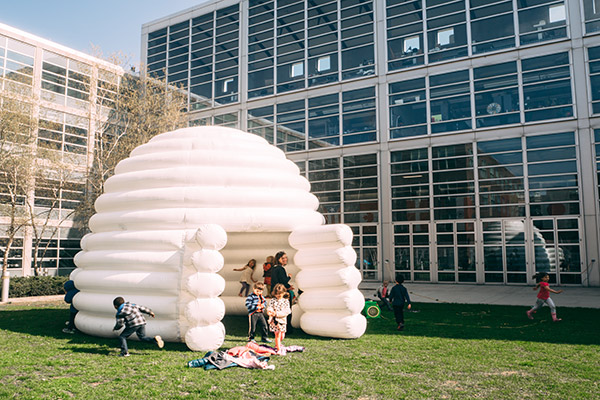
Designed by a group of Undergraduate and Graduate Students
Racial and Economic Equity
Associate Professor Kirk Harris’ academic interests are focused on racial and economic equity, the pedagogy of social justice, constitutional issues in planning law and mediation and negotiation. Dr. Harris leads a research, practice and policy initiative in Chicago, Fathers, Families and Healthy Communities (FFHC). This family strengthening and community development initiative seeks to support and promote the engagement of low-income African-American fathers in the lives of their children, families and communities.
Kirk teaches courses on negotiation theory and practice for urban planners, social justice, multiculturalism, race and class, and planning law. He is a lawyer as well as a planner.
He was the keynote speaker, “Criminalization and Punishment: Implications for Child Support Practice and Policy,” at the Office of Child Support Enforcement, Chicago, in June 2016, and a panelist on “Child Support: Innovations in State Policy & Practice to Remove Barriers to Work” at the National Conference on Ending Chronic Unemployment and Poverty, sponsored by Heartland Alliance in October 2016.
He moderated a session on race, education and gentrification and was a panel presenter on “Getting Tenure Panel” at the 2017 Urban Affairs Conference. In 2016 he presented on economic and social justice and the planning practice imperative. He spoke on family strengthening, father engagement and community building at the national March of Dimes Symposium on the social determinants of health.
Kirk provided opening remarks and moderated the 2017 Wisconsin Chapter of the American Planning Association “Planning and a Pint” panel on Diversity in Planning and served as a panelist in the 2016 panel discussion on governmental policy and racial segregation and disparity.
Kirk is currently working on a book on Black mayors and equity practices in community and economic development.
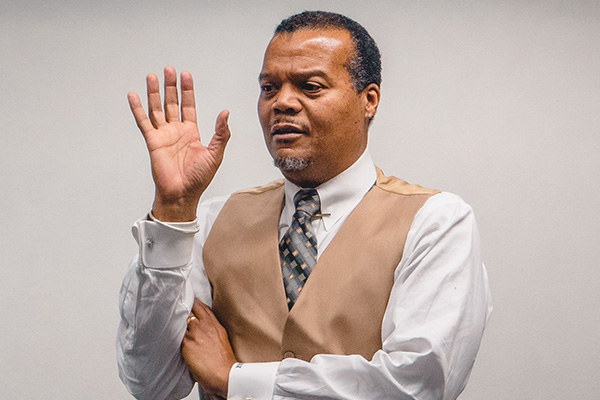
In May 2017, community thought leaders joined in conversation at the Museum of Wisconsin Art in West Bend about how Milwaukee is embracing a more expansive view of public art that shifts the conversation from explicit objects and buildings to spaces of influence. The program was part of MOWA’s museum-wide spring exhibition, Hyperphotographic. Participants included: Tom Bamberger, Photographer; Urban Design/Architecture Critic; Sara Daleiden, Consultant, Creative Placemaking Committee of the Greater Milwaukee Committee (GMC); Tom Kubala, Co-founder, The Kubala Washatko Architects, Inc.; Arijit Sen, Associate Professor of Architecture, UWM; Jim Shields, Design Principal, HGA Architects; Associate Professor of Architecture, UWM; and Laurie Winters, CEO, Museum of Wisconsin Art.
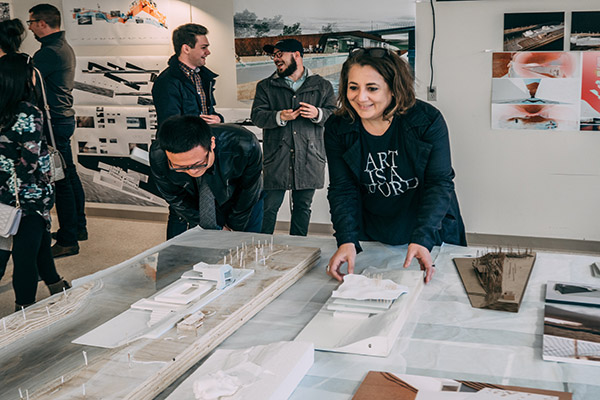
Congratulations!
